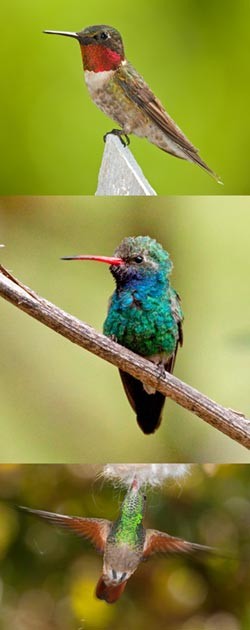
They are the epitome of avian energy, hovering, darting, and flowing like no other birds, almost as if they weren’t birds at all but rather androids or creatures borne from the sparks of our imagination. Ecuador has 130 species. Arizona has more than a dozen. In the Northeast, for most of the year, our hummingbird diversity is a grand total of one.
Hummingbirds reach maximum diversity in the mountains of northern South America. Descend from the Andes of Venezuela, Colombia, or Ecuador, or venture toward the temperate latitudes of North America, and the hummingbird diversity falls abruptly. We’re fortunate to have even a single species here – the ruby-throated hummingbird – a bird weighing about one-eighth of an ounce that migrates between breeding grounds in eastern North American and wintering habitat from Mexico to Central America.
Well known is a hummingbird’s physiological acumen: a flight velocity of about 50 miles per hour, wing beats of 70 per second, and a heart rate sometimes exceeding 1,000 beats per minute. But lesser known is a hummingbird’s indifferent love life. Forget the notion of a pair setting up a territory, courting, building a nest, mating, raising young, and living happily at your sugar feeder until fall. Hummingbirds have no such family values.
Male hummingbirds establish their own territories, usually habitat with good nectar sources and the opportunity to copulate with as many females as might wander by. After their brief encounter, males and females rarely meet again. Females establish and defend their own territories, not necessarily near any male with which she might have mated. She looks for rich food supplies and favorable nesting sites. And she alone handles all the remaining reproductive duties: building a nest, incubating eggs, and raising young.
In late summer and fall, when the young are on their own, as average temperatures drop and nectar sources begin to dry up, hummingbirds across the continent begin to migrate. Sometimes they go off course – way off course. This is when it can get interesting in the East.
The rufous hummingbird, which breeds in western North America, regularly shows up east of the Mississippi River in fall; the species now winters in the southeastern U.S. In August of 2008, a broad-billed hummingbird, which really had no business being away from Mexico or the southeastern corner of Arizona, showed up at a feeder in Dennis, Massachusetts. And when it should be in Mexico, the calliope hummingbird, the smallest bird in North America – roughly a heaping tablespoon of green feathers with some purplish flecks on its throat – has been showing up anywhere from Maryland to Maine.
So, if you’re duly inclined, keep those feeders full into the fall. It won’t mess with the ruby-throat’s departure date; birds are smarter than we think. You might instead see the flash and sparkle of some wayward visitor.

